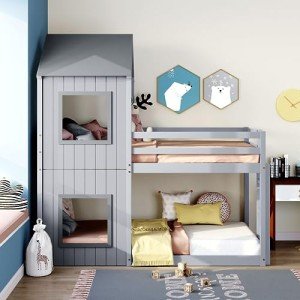20 Fun Facts About Bunk Beds

Exploring Bunk Beds: A Comprehensive Guide
Bunk beds have long been a staple in children's bed rooms, dorms, and even homes with minimal space. Not just do they provide a practical sleeping solution, however they also produce a fun and imaginative environment for children and a great space-saver for adults and households. This article will explore whatever you need to understand about bunk beds, from types and materials to security ideas and purchasing suggestions.
Tabulation
- Types of Bunk Beds
- Conventional Bunk Beds
- Loft Beds
- Triple Bunk Beds
- L-Shaped Bunk Beds
- Material Options
- Wood
- Metal
- Safety Considerations
- Purchasing Guide
- FAQs
Kinds Of Bunk Beds
Bunk beds can be found in various designs to match various needs and preferences. Here's a breakdown of the most typical types:
Conventional Bunk Beds
Standard bunks normally include 2 beds stacked vertically on top of one another. These beds are perfect for siblings sharing a room or for taking full advantage of sleeping space in guest spaces.
Loft Beds
Loft beds stand similarly to standard bunk beds however do not have a lower sleeping location. Instead, they typically incorporate a desk or seating area below, making them a great option for little spaces needing multifunctionality.
Triple Bunk Beds
Triple bunk beds are created for three occupants, with beds stacked in a three-tier setup. These are less common however can be a fun option for big families or slumber parties.
L-Shaped Bunk Beds
With one bed positioned horizontally and the other vertically, L-shaped bunk beds are frequently geared up with extra functions such as desks or storage drawers and can match corner spaces in a space.
Contrast of Bunk Bed Types
| Bed Type | Perfect Use | Description |
|---|---|---|
| Traditional | Shared bedrooms or guest spaces | Two beds stacked vertically |
| Loft | Small spaces needing multi-purpose space | Upper bed with open space underneath |
| Triple | Large families or pajama parties | Three beds stacked vertically |
| L-Shaped | Corner or flexible areas | A combination of vertical and horizontal beds |
Material Options
Bunk beds are manufactured from various products, with wood and metal being the most common. Each material has its advantages and disadvantages.
Wood
- Toughness: Generally robust and can hold up against years of use.
- Aesthetic Appeal: Offers a traditional appearance that can mix with numerous decorations.
- Weight Capacity: Typically sturdier; can support much heavier weights.
- Downsides: May be more costly than metal choices and can be vulnerable to scratches.
Metal
- Durability: Generally light-weight and simple to move however still sturdy.
- Modern Design: Often can be found in smooth styles, making it appealing for modern spaces.
- Economical: Usually less costly than wooden options.
- Disadvantages: Can be cold to the touch in winter seasons and may not have the exact same visual appeal for some buyers.
Security Considerations
When it comes to bunk beds, security can not be overlooked. Here are essential safety pointers to keep in mind:
- Guardrails: Ensure that the top bunk has guardrails on both sides to avoid falls.
- Strong Construction: Check for a solid develop and durable products to endure weight and motion.
- Weight Limit: Adhere to the manufacturer's weight limitation for both the upper and lower bunks.
- Ladder Design: Choose bunks with a safe, easy-to-climb ladder and avoid any sharp edges or rungs.
- Age Restrictions: Most manufacturers recommend that kids under the age of six should not sleep in the upper bunk.
Buying Guide
When searching for bunk beds, think about the following factors to find the very best fit for your needs:
- Space Availability: Measure the space size and ceiling height, guaranteeing there is sufficient space for the top bunk.
- Bed Size: Decide in between twin, full, or larger sizes based upon your requirements and the size of the room.
- Style Preference: Consider the general decor of the bedroom to discover an appropriate style.
- Alleviate of Setup: Look for a bunk bed that is straightforward to assemble.
- Spending plan: Bunk beds come in numerous rate varieties, so identify a budget before starting your search.
FAQs
1. What is the advised age for children to sleep on the top bunk?
Kids aged 6 and older are usually recommended to sleep on the top bunk to lessen the threat of falls.
2. How can I make my bunk bed safer?
To improve security, make sure guardrails are appropriately set up and examine that the bed is placed on a flat surface area. In addition, encourage kids to utilize the ladder thoroughly.
3. Can I transform a bunk bed into two different beds?
Many bunk beds are designed to be convertible. Check Bed Bunk For Sale rahulmcmillan.top for convertibility functions.
4. What accessories are offered for bunk beds?
Common accessories consist of bed linens, storage drawers, staircases instead of ladders, and tented canopies for an enjoyable visual appeal.
5. How do I preserve my bunk bed?
Routine look for loose screws or structural integrity can assist ensure security. Dust the bed frequently and clean spills promptly to keep the products in good condition.
Bunk beds are versatile and a space-efficient option for numerous living scenarios, from kids's rooms to guest lodgings. With numerous designs and products offered, possible purchasers have a wealth of alternatives to think about, guaranteeing a mix of functionality and aesthetic appeals. By focusing on security and following the tips described in this guide, people can find the right bunk bed that matches their space and lifestyle, all while creating an enjoyable sleeping environment.

